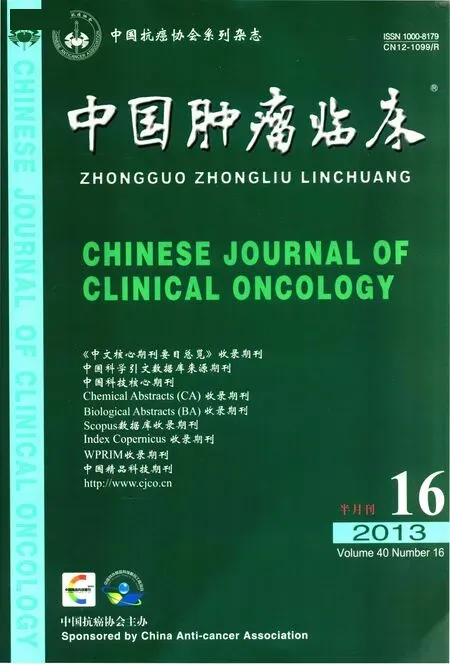肝癌多药耐药机制研究进展
李慧锴 综述 李 强 审校
肝癌多药耐药机制研究进展
李慧锴 综述 李 强 审校
原发性肝癌是我国常见的恶性肿瘤之一,化疗是中晚期肝癌综合治疗的重要手段,但肝癌化疗多药耐药现象严重阻碍了化疗的效果。目前肝癌多药耐药的机制仍不明确,主要包括跨膜转运蛋白泵药作用,细胞内酶系统改变,MAPK信号转导系统的激活,控制凋亡的基因和蛋白的改变,肿瘤微环境的影响等。近年随着研究的不断深入,又有新的相关机制报道,如内质网应激和microRNA在肝癌耐药中发挥着不可忽视的作用。本文就近年来肝癌多药耐药的相关研究进展做简要综述,为临床提供新的思路。
原发性肝癌 多药耐药 化疗
原发性肝癌是我国常见的恶性肿瘤之一,全世界每年约有50万例新发患者,其中50%发生在我国,并呈逐年上升趋势[1]。肝癌具有多血管、恶性程度高、生长速度快、转移范围广和复发率高等特点,临床治疗效果不理想。治疗原发性肝癌以手术切除为首选方法,但术后复发率较高,而且大多数患者就诊时已丧失手术机会,只能进行辅助性综合治疗[2]。化疗是中晚期肝癌综合治疗的重要手段,但肝癌化疗多药耐药(multidrug resistance,MDR)现象严重阻碍了化疗的效果,因此,研究引起肝癌MDR的相关因素、作用机制并逆转MDR,提高肝癌化疗效果成为亟待解决的问题之一。
1 肿瘤MDR相关机制
肿瘤MDR是指在肿瘤化疗中细胞对于一种化疗药物产生耐受后,同时对其他同一或非同一类型的化疗药物也产生耐药。据统计,90%以上的肿瘤患者化疗失败的原因都不同程度地与MDR有关。MDR的产生机制尚未阐明,目前认为肿瘤化疗MDR的主要分子生物学机制涉及以下几个方面。
1.1 跨膜转运蛋白减少药物在细胞中聚集
跨膜转运蛋白将化疗药物从肿瘤细胞中泵出,从而减少药物在细胞中聚集。这类蛋白属于ATP结合盒(ATP-binding cassette,ABC)转运蛋白,主要包括P-糖蛋白(P-glycoprotein,P-gp)、MDR相关蛋白(multidrug resistance protein,MRP)以及乳腺癌耐药相关蛋白(breast cancer resistance protein,BCRP)等。P-gp是一类由MDR1基因编码的跨膜糖蛋白,可将细胞内多种抗肿瘤药物泵出细胞外,使细胞内药量低而无法有效杀灭肿瘤细胞。它还可促使药物在细胞内再分布,积聚于与药物作用无关的细胞器内,进一步降低作用于靶点部位的药物浓度,导致耐药[3]。
1.2 细胞内酶系统发生改变
还原型谷胱苷肽(reduced glutathione hormone,GSH)和谷胱苷肽巯基转移酶(glutathione S-transfer-ase,GST)的活化,DNA拓扑异构酶(Topoisomerase,TOPO)和蛋白激酶C(Protein Kinase C,PKC)的活性降低,都可能参与肿瘤细胞多药耐药的发生[4-6]。
1.3 MAPK信号转导系统的激活
丝裂原活化蛋白激酶(mitogen-activated protein kinase,MAPK)是哺乳动物细胞内广泛存在的一类丝氨酸/苏氨酸蛋白激酶,MAPK信号转导通路是介导细胞外刺激到细胞内反应的重要信号转导系统,调节着细胞的增殖、分化、凋亡和细胞间相互作用。资料显示,MAPK通路在肿瘤化疗耐药中发挥着重要的作用,抗肿瘤药物能够引起MAPK信号转导系统的激活及MDR的产生[7]。
1.4 控制凋亡的基因和蛋白的改变
多数化疗药物通过诱导肿瘤细胞凋亡来杀灭肿瘤细胞,细胞凋亡是一种由基因控制的细胞程序化死亡过程,肿瘤细胞MDR的产生也是抵抗和逃逸凋亡。随着人们对肿瘤耐药研究认识的深入,更多的基因被发现与肿瘤耐药密切相关。细胞凋亡有关因子及基因如 NF-κB、bcl-2、c-Jun、p53、erbB2/neu、c-myc等都参与肿瘤细胞的耐药[8-9]。
1.5 肿瘤微环境的改变
大量和长时间的的炎症刺激和纤维化形成促进了肝硬化和肝癌的形成和发展,其中基质成分与癌细胞和信号通路间的相互作用是造成肝癌耐药的重要原因之一。乏氧诱导因子1(hypoxia inducible factor 1,HIF-1)在缺氧条件下广泛存在于人与动物肿瘤细胞内,可调控MDR基因I(MDR1)的表达,诱导MDR1/P-gp表达升高,同时通过促进血管形成、红细胞生成、糖代谢以及调节细胞凋亡、细胞周期等途径,使细胞适应乏氧微环境,是肿瘤预后差,易产生放疗、化疗耐受性的重要原因之一[8-9]。
2 肝癌MDR相关机制及研究进展
2.1 ABC转运蛋白将化疗药物从肝癌细胞中泵出
P-gp分子量为150~180 kDa,为ABC转运蛋白家族中的典型代表,由MDR1基因编码,通常认为其定位于细胞膜,将化疗药物泵出,以降低细胞内药物浓度,使用抗P-gp核酶可逆转肝癌细胞耐药性[10-11]。P-gp还分布于阿霉素诱导的耐药细胞系的细胞核膜表面,可使化疗药物从细胞核泵出[12]。但是P-gp在肝癌中的作用存在着争议。P-gp在HCC中的表达个体差异比较大,有学者通过对人肝癌组织和实验大鼠肝肿瘤的研究发现,P-gp过量表达与肿瘤进展和生存减低密切相关;而另有研究发现一部分HCC中P-gp的表达与肿瘤恶性分型和生存不相关,联合使用P-gp的调节剂维拉帕米并不能逆转HCC的MDR。P-gp还可以调节细胞凋亡,首先P-gp把药物和有毒物泵出胞外,然后影响caspase-3的激活,减少细胞凋亡[13]。
2.2 肿瘤微环境对肝癌耐药的影响
肿瘤微环境指细胞外基质中的瘤样复合物,包括基质细胞和其所分泌的蛋白,这些物质促进肿瘤进展。肝癌微环境由肝癌细胞及其周围淋巴细胞、肝星状细胞、纤维母细胞、特异性免疫细胞,肿瘤血管和淋巴管等构成。这些细胞维持肝癌的增殖、逃逸生长抑制,诱导血管形成,促进侵袭和转移以及进行免疫破坏等。肿瘤内血供差减少了化疗药物与肿瘤细胞的接触使其耐药。肝脏有丰富的血供,但异常新生血管是功能异常而局部缺氧,局部的缺血缺氧使得化疗药物作用降低,因为许多化疗药物需要与氧分子发生反应产生细胞毒素后发挥作用。肝癌细胞缺氧微环境可诱导核转录因子HIF-1的表达,在转录水平调控多药耐药相关基因的表达,从而诱导肝癌多药耐药表型的形成,因此HIF-1α的表达上调是微环境诱导肝癌多药耐药形成的中心环节[14]。缺氧微环境下,肝癌细胞发生上皮-间叶转化(epithelial-mesenchymal transition,EMT),细胞侵袭和迁移能力增强,对药物敏感性明显降低。而间质细胞、胞外基质和肿瘤细胞自身通过与肿瘤细胞直接接触,以粘附分子为介质诱导耐药[15-16]。
2.3 microRNA表达异常
microRNA是一类长度在22nt左右的非编码RNA基因产物,通过与mRNA的3’UTR结合而介导翻译水平的调控。研究表明在肝癌细胞中某些microRNA表达异常,其通过调节很多重要的肿瘤相关基因影响肝癌细胞的生物学功能。miR-106b在肝癌细胞中明显上调,靶向作用APC(adenomatous polyposis coli),激活Wnt/β-catenin信号通路,影响G1/S期,促进肝癌细胞的增殖。miR-490-3p在肝癌细胞表达增高,通过靶向作用ERGIC3调节细胞生长和促使上皮细胞向间叶细胞分化。miR-122是肝特异性miRNA,在肝癌细胞中过表达可增加细胞对化疗药物阿霉素和长春新碱的敏感性,并且能够影响细胞周期,使G2/M期延长[17-19]。
2.4 内质网应激诱导肝癌耐药
内质网(endoplasmic reticulum,ER)是真核细胞中蛋白质合成、折叠与分泌的重要细胞器。内质网具有极强的内稳态体系,但仍然有很多因素可导致ER功能的内稳态失衡,形成内质网应激(ER stress)。ER应激时ER内未折叠蛋白质或错误折叠蛋白的蓄积,称为未折叠蛋白反应(unfolded protein response,UPR),从根本上讲ER应激是细胞为适应环境变化而做出的一系列代偿性保护应答。ER应激首先启动生存途径,通过增强蛋白质的正确折叠,减少蛋白质的合成,清除错误折叠的蛋白使ER稳态恢复平衡;如果ER功能紊乱持续,细胞将最终启动凋亡程序[20]。使用UPR诱导剂GRP78处理后的肝癌细胞中P-gp转录激活,表达增加,进而影响药物的敏感性[21]。
2.5 乙肝病毒感染的影响
合并乙肝病毒感染的HCC对化疗药物敏感性差,可能与乙肝病毒中HBV X基因编码蛋白有关。HBX编码蛋白是主要的功能蛋白,可直接或间接促进肝炎向肝癌发展。在肝癌细胞系HepG2中过表达HBX,可使细胞产生MDR,凋亡明显减少;且NF-κB活性明显增强[22]。
综上,肝癌MDR的产生是多基因、多因素、多途径、多步骤综合作用的复杂过程,研究引起肝癌MDR的相关因素、作用机制及逆转MDR,提高肝癌化疗效果成为目前肝癌研究的热点。
1 Ferenci P,Fried M,Labrecque D,et al.Hepatocellular carcinoma(HCC):a global perspective.J Clin Gastroenterol[J].J Clin Gastroenterol,2010,44(4):239-245.
2 Qiang L,Huikai L,Butt K,et al.Factors associated with disease survival after surgical resection in Chinese patients with hepatocellular carcinoma[J].World J Surg,2006,30(3):439-445.
3 Martelli C,Dei S,Lambert C,et al.Inhibition of P-glycoprotein-mediated Multidrug Resistance(MDR)by N,N-bis(cyclohexanol)amine aryl esters:Further restriction of molecular flexibility maintains high potency and efficacy[J].Bioorg Med Chem Lett,2010.
4 Burg D,Riepsaame J,Pont C,et al.Peptide-bond modified glutathione conjugate analogs modulate GSTpi function in GSH-conjugation,drug sensitivity and JNK signaling[J].Biochem Pharmacol,2006,71(3):268-277.
5 Perez-Sayans M,Somoza-Martin JM,Barros-Angueira F,et al.Multidrug resistance in oral squamous cell carcinoma:The role of vacuolar ATPases[J].Cancer Lett,2010,295(2):135-143.
6 Sun LR,Zhong JL,Cui SX,et al.Modulation of P-glycoprotein activity by the substituted quinoxalinone compound QA3 in adriamycin-resistant K562/A02 cells[J].Pharmacol Rep,2010,62(2):333-342.
7 Ling X,He X,Apontes P,et al.Enhancing effectiveness of the MDR-sensitive compound T138067 using advanced treatment with negative modulators of the drug-resistant protein survivin[J].Am J Transl Res,2009,1(4):393-405.
8 Gillet JP,Gottesman MM.Mechanisms of multidrug resistance in cancer[J].Methods Mol Biol,2010,596:47-76.
9 Kutuk O,Basaga H.Bcl-2 protein family:implications in vascular apoptosis and atherosclerosis[J].Apoptosis,2006,11(10):1661-1675.
10 Qia S,Wang H,Chen X.Reversal of HCC drug resistance by using hammerhead ribozymes against multidrug resistance 1 gene[J].J Huazhong Univ Sci Technolog Med Sci,2005,25(6):662-664.
11 Huesker M,Folmer Y,Schneider M,et al.Reversal of drug resistance of hepatocellular carcinoma cells by adenoviral delivery of anti-MDR1 ribozymes[J].Hepatology,2002,36(4 Pt 1):874-884.
12 Maraldi NM,Zini N,Santi S,et al.P-glycoprotein subcellular localization and cell morphotype in MDR1 gene-transfected human osteosarcoma cells[J].Biol Cell,1999,91(1):17-28.
13 Comerford KM,Wallace TJ,Karhausen J,et al.Hypoxia-inducible factor-1-dependent regulation of the multidrug resistance(MDR1)gene[J].Cancer Res,2002,62(12):3387-3394.
14 Zhu H,Chen XP,Luo SF,et al.Involvement of hypoxia-inducible factor-1-alpha in multidrug resistance induced by hypoxia in HepG2 cells[J].J Exp Clin Cancer Res,2005,24(4):565-574.
15 Solazzo M,Fantappie O,Lasagna N,et al.P-gp localization in mitochondria and its functional characterization in multiple drug-resistant cell lines[J].Exp Cell Res,2006,312(20):4070-4078.
16 Hernandez-Gea V,Toffanin S,Friedman SL,et al.Role of the Microenvironment in the Pathogenesis and Treatment of Hepatocellular Carcinoma[J].Gastroenterology,2013,144(3):512-527.
17 Shen G,Jia H,Tai Q,et al.miR-106b downregulates adenomatous polyposis coli and promotes cell proliferation in human hepatocellular carcinoma[J].Carcinogenesis,2013,34(1):211-219.
18 Xu Y,Xia F,Ma L,et al.MicroRNA-122 sensitizes HCC cancer cells to adriamycin and vincristine through modulating expression of MDR and inducing cell cycle arres[J].Cancer Lett,2011,310(2):160-169.
19 Zhang LY,Liu M,Li X,et al.miR-490-3p modulates cell growth and epithelial to mesenchymal transition of hepatocellular carcinoma cells by targeting endoplasmic reticulum-Golgi intermediate compartment protein 3(ERGIC3)[J].J Biol Chem,2013,288(6):4035-4047.
20 Kim R,Emi M,Tanabe K,et al.Role of the unfolded protein response in cell death[J].Apoptosis,2006,11(1):5-13.
21 Ledoux S,Yang R,Friedlander G,et al.Glucose depletion enhances P-glycoprotein expression in hepatoma cells:role of endoplasmic reticulum stress response[J].Cancer Res,2003,63(21):7284-7290.
22 Liu Y,Lou G,Wu W,et al.Involvement of the NF-kappaB pathway in multidrug resistance induced by HBx in a hepatoma cell line[J].J Viral Hepat,2011,18(10):e439-446.
(2013-05-13收稿)
(2013-06-20修回)
Mechanisms of Multidrug-resistance in hepatocellular carcinoma
Huikai Li;E-mail:tjchlhk@126.com
Department of Hepatobiliary Surgery,Tianjin Medical University Cancer Institute and Hospital,National Clinical Research Center of Cancer,Tianjin 300060,China
Hepatocellular carcinoma(HCC)is one of the common malignant tumors in China.The most important treatment for middle-late stage HCC is chemotherapy.However,the development of multidrug resistance(MDR)in HCC can dramatically reduce the efficacy of chemotherapeutic treatment.At present,the mechanisms regulating the development of MDR in HCC are still unknown.These mechanisms involve ATP-dependent drug efflux pump,enzymatic deactivation,the activation of MAPK signal pathway,apoptosis gene and protein changing,the influence of the tumor microenvironment,and so on.With the development of the research,some new mechanisms are found,such as the endoplasmic reticulum stress and the effect of microRNA,which cannot be ignored.This review aims to summarize the mechanisms of MDR in HCC and discuss potential therapeutic targets for anticancer intervention.
hepatocellular carcinoma,multidrug resistance,chemotherapy
10.3969/j.issn.1000-8179.20131377
天津医科大学肿瘤医院肝胆肿瘤科,国家肿瘤临床医学研究中心(天津市300060)
李慧锴 tjchlhk@126.com
Huikai Li,Qiang Li
(本文编辑:贾树明)

